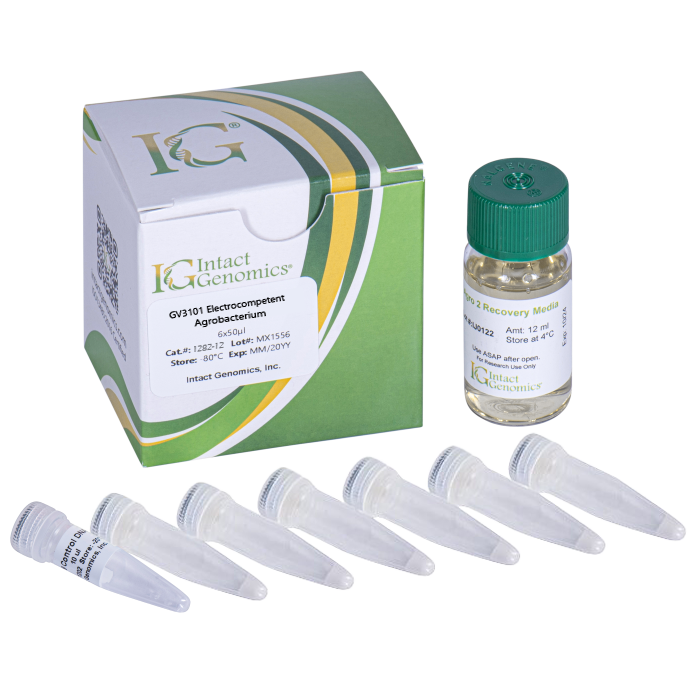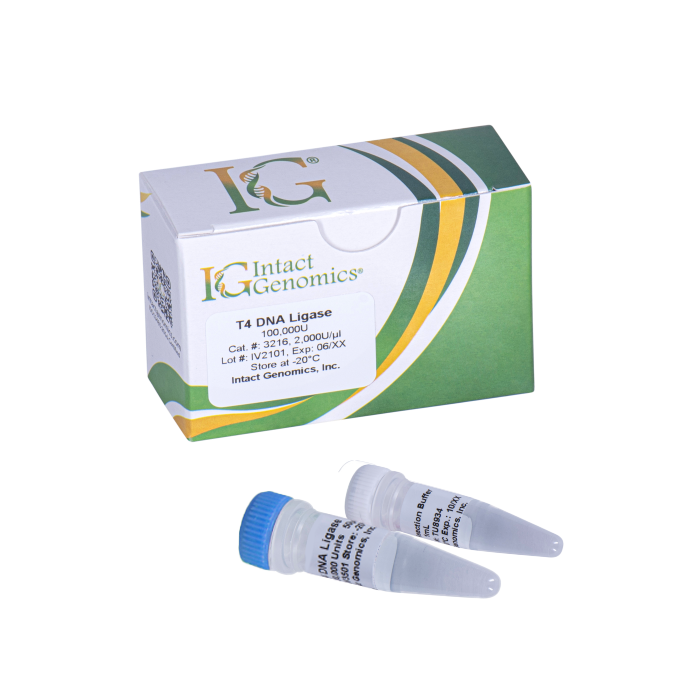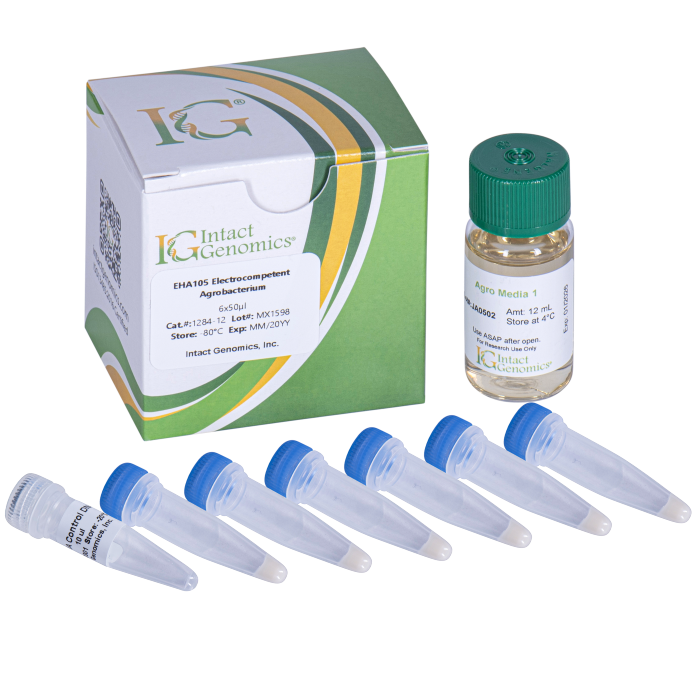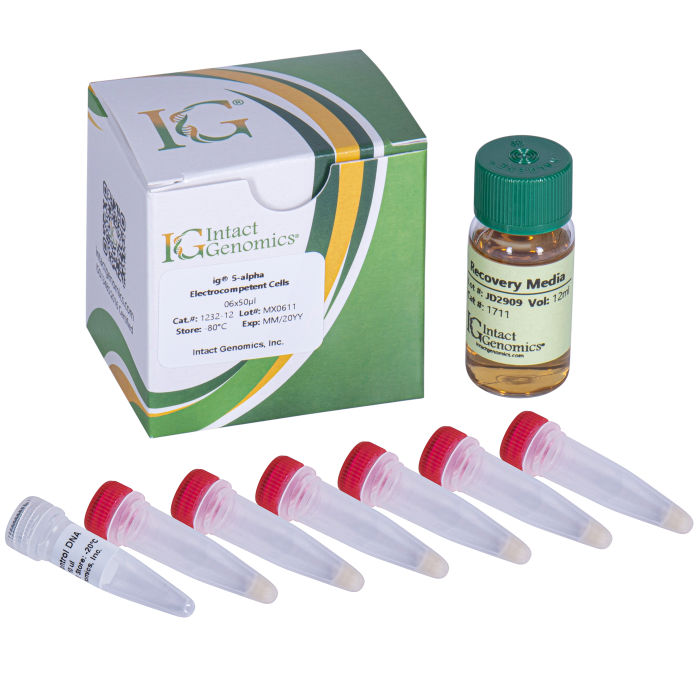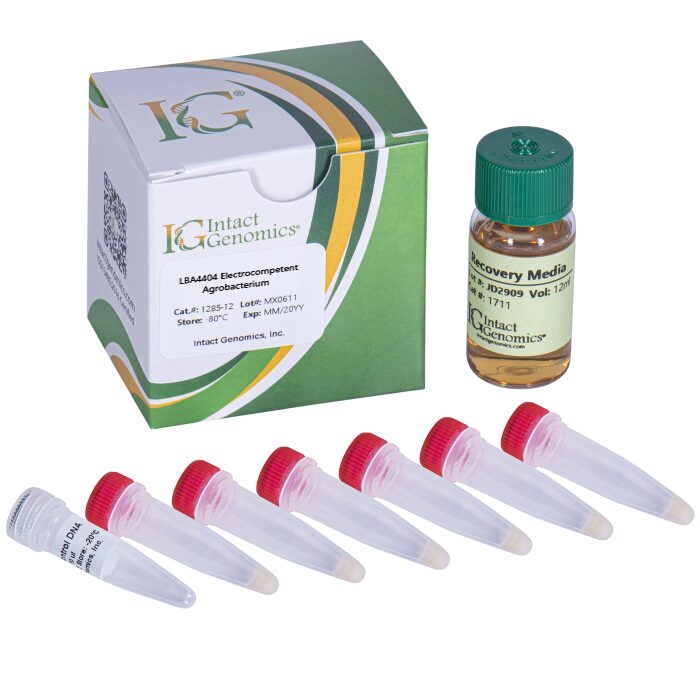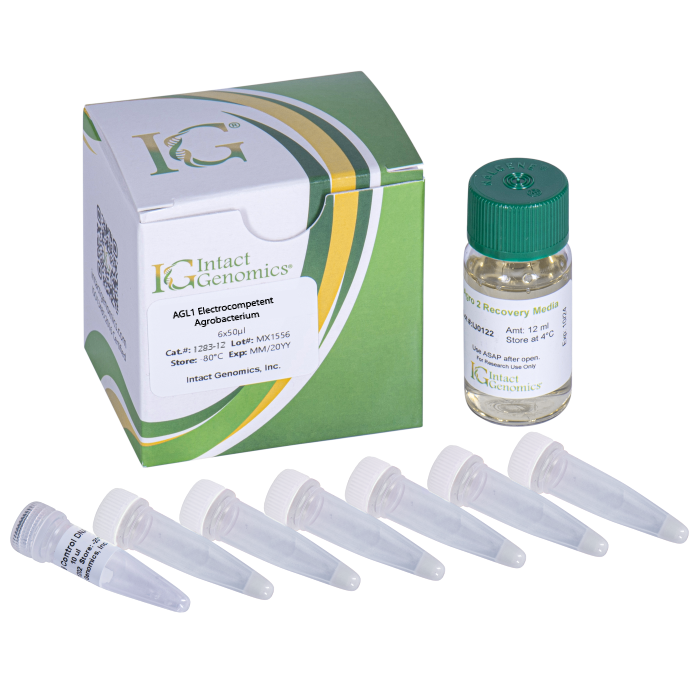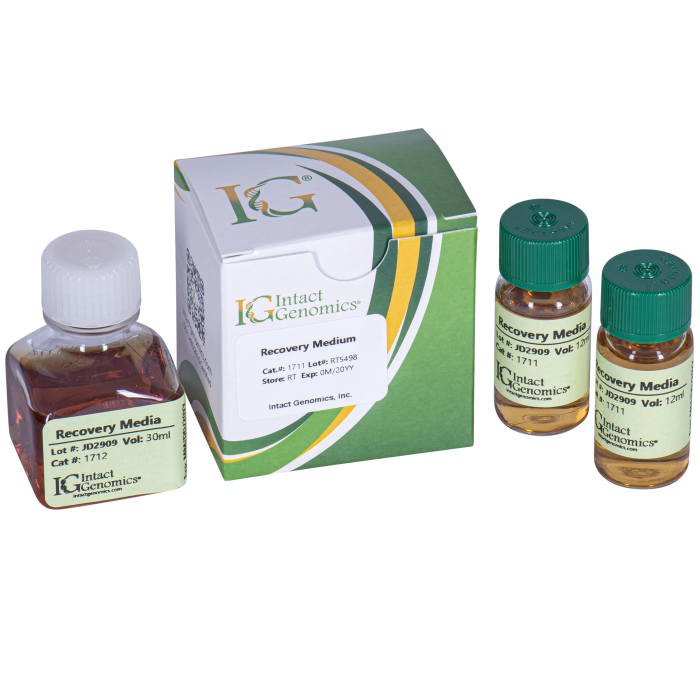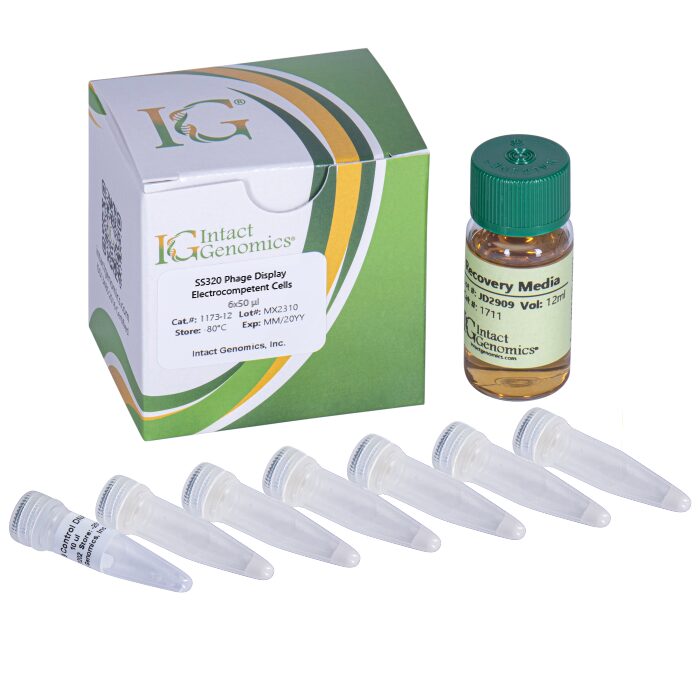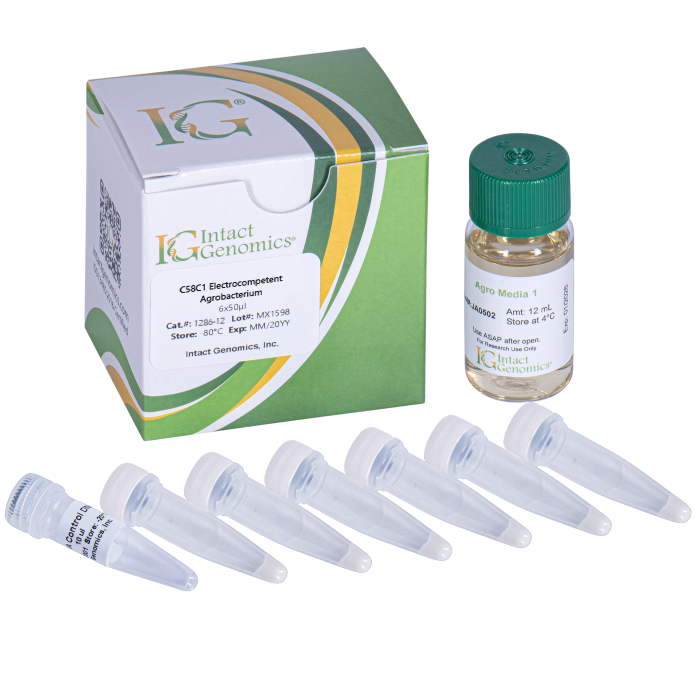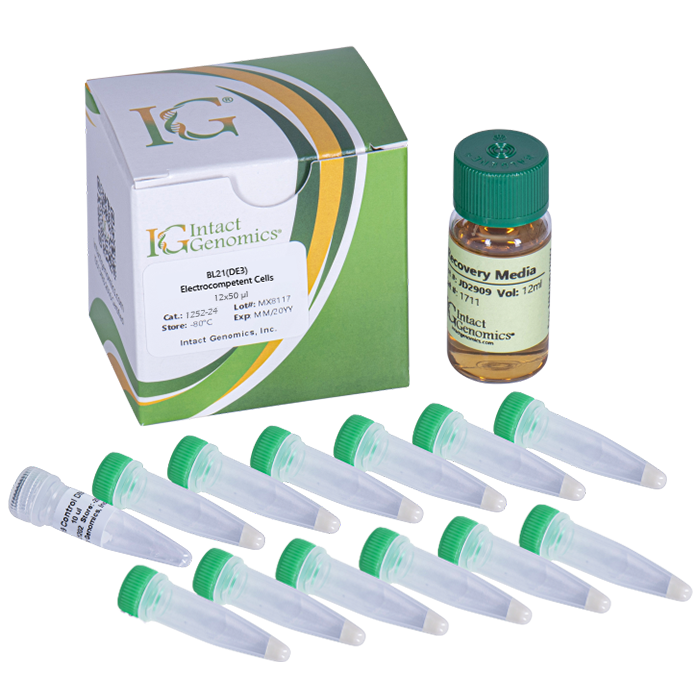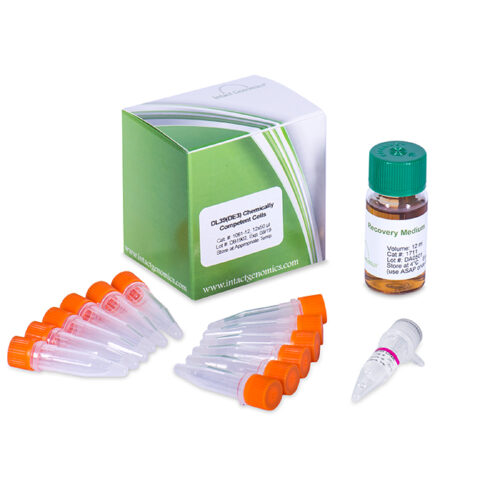Useful for Agrobacterium-mediated genetic transformation of Arabidopsis thaliana, tobacco, corn, potatoes, and other plants.
GV3101 Agrobacterium ElectroCompetent Cells
Price range: $199.00 through $549.00
Description
Intact Genomics GV3101 Agrobacterium ElectroCompetent Cells are optimized for the highest transformation efficiencies which is ideal for applications requiring high transformation efficiencies, such as with cDNA or gDNA library construction.
The GV3101 strain has a C58 chromosomal background with rifampicin resistance and the Ti plasmid pMP90 (pTiC58DT-DNA) with gentamicin resistance. The GV3101 Ti plasmid has the T-DNA region sequences deleted and transformation with a binary vector containing the missing T-region results in a functional T-DNA binary system that allows for transfer of genetic material into a host plant’s genome. Therefore, this system is often used for Agrobacterium-mediated transformation of several dicots such as Arabidopsis thaliana, tobacco, potatoes, and monocots like corn.
Specifications
Competent cell type: Electrocompetent
Species: A. tumefaciens
Strain: GV3101
Format: Tubes
Transformation efficiency: ≥ 1 x 107 cfu/µg pCAMBIA1391z DNA
Blue/white screening: No
Shipping condition: Dry ice
Reagents Needed for One Reaction
GV3101 Agrobacterium ElectroCompetent Cells: 25 µl
DNA (pCAMBIA1391z, 500 pg/µl): 1 µl
Recovery medium: 1 ml
Storage
GV3101 Agrobacterium ElectroCompetent Cells: -80 ºC
pCAMBIA1391z control DNA: -20 ºC
Recovery medium: 4 ºC
Quality Control
Transformation efficiency is tested by using the pCAMBIA1391z control DNA supplied with the kit and using the protocol in this manual. Transformation efficiency should be ≥1 x 107 CFU/µg pCAMBIA1391z DNA. Untransformed cells are tested for appropriate antibiotic sensitivity.
Calculation of Transformation Efficiency
Transformation Efficiency (TE) is defined as the number of colony forming units (cfu) produced by transforming 1µg of plasmid into a given volume of competent cells.
TE = Colonies/µg/Plated
Transform 1 µl of (500 pg/µl) pCAMBIA1391z control plasmid into 25 µl of cells, add 974 µl of Recovery Medium. Recover for 3 hours and plate 100 µl. Count the colonies on the plate in two days. If you count 500 colonies, the TE is calculated as follows:
Colonies = 500
µg of DNA = 0.0005
Dilution = 100/1000 = 0.1
TE = 500/.0005/.1 = 1×107
Please note, all agrobacterial strains are not well studied for antibiotic resistance and there are many agrobacterial strains. Therefore, it is the customer’s responsibility to make sure his/her vectors are compatible with the Agrobacterial strains if he/she uses an alternate antibiotic selection than kanamycin-selection.1282-12 1282-20 1282-36
Additional information
| µl | 6×50µl, 10×50µl, 18×50µl |
|---|
Transformation Protocol
Use this procedure to transform GV3101 ElectroComp. Agrobacterium. Do not use these cells for chemical transformation.
1) Place sterile cuvettes and microcentrifuge tubes on ice.
2) Remove competent cells from the -80 °C freezer and thaw completely on wet ice (10-15 minutes).
3) Aliquot 1 µl ( 10pg -1 µg) of DNA to the chilled microcentrifuge tubes on ice.
4) When the cells are thawed, add 25 μl of cells to each DNA tube on ice and mix gently by tapping 4-5 times. For the pCAMBIA1391z control, add 1 µl of (500 pg/µl) DNA to the 25 µl of cells on ice. Mix well by tapping. Do not pipette up and down or vortex to mix, this can harm cells and decrease transformation efficiency.
5) Pipette 26 µl of the cell/DNA mixture into a chilled electroporation cuvette without introducing bubbles. Quickly flick the cuvette downward with your wrist to deposit the cells across the bottom of the well and then electroporate.
6) Immediately add 974 µl of Recovery Medium or any other medium of choice to the cuvette, pipette up and down three times to re-suspend the cells. Transfer the cells and Recovery Medium to an Eppendorf tube.
7) Incubate tubes at 30 °C for 3 hours at 200 RPM.
8) Dilute the cells as appropriate then spread 20-200 μl cells onto a pre-warmed selective plate. For the pCAMBIA1391z control, you may plate 100 μl of undiluted transformation mix onto a YT plate containing 15 μg/ml rifampicin and 50 μg/ml kanamycin. Use a sterilized spreader or autoclaved ColiRoller™ plating beads to spread evenly.
9) Incubate the plates for 2 – 3 days at 30 °C.
Electroporation settings
Mode: Exponential protocol
Voltage (V): 1,800 V
Capacitance: 25 uFD
Resistance: 200 Ohms
Cuvette: 1 mm

